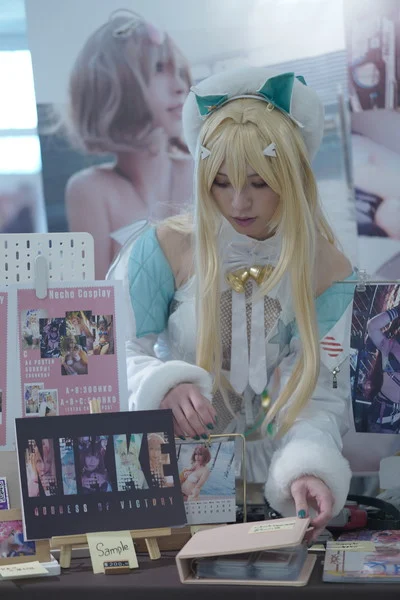Sounds of muddled conversation, obscured by throngs of people so densely packed you had to just go with the flow, weaving over barriers and people equally as you passed through the hallways used for photography.
The 30th Rainbow Gala (RG), the largest doujinshi conference for locally produced goods in Hong Kong, took place on December 23 and 24. The event was a signal hellscape, with only sporadic calls being made because cellular service was barely able to handle the demand and might even be closing down.

With 60,000 square feet of event space spread across three different halls and 900,000 square feet of mall area outside for participants to hang out, RG is the only anime doujinshi event of this kind to have been staged in Hong Kong. It debuted in 2007 and coexisted with competitor events including Comic World (CW) from 1998 to 2009 and C3AFA from 2009 until its closure in 2021.
Kowlonbay International Trade & exposition Centre (KITEC), an RG facility that hosts a range of events, concerts, and other exposition functions—including a performance by Japanese singer ReoNa on January 28—has played host to numerous anime events.
Given the recent efforts at regeneration, KITEC is scheduled for demolition in June 2024.
Necho Nara, an eight-year cosplayer and one-year exhibitor, responded to inquiries over the possible loss of RG by saying they don’t think the fallout will be severe since people will eventually “move on” and grow used to it, much like how people “forgot all about CW after just two years of inactivity.”
But Nara also mentioned that exhibitors would lose one more revenue stream if RG were to disappear.
Cosplayer and self-described “workaholic” Harry Tsang said that losing RG is “one less outlet for expression,” while three-year exhibitor Kazu Tang feels that the doujinshi scene would get smaller once KITEC closes. Photographer Andrew Hui made a joke about how the closing was like losing family while also saying that at least it will stop the “trashy signal black hole.”
“Hopefully, RG could find another venue, like D2 Place, but it won’t live up to the landmark status of KITEC as the home of doujinshi events,” Tang said.
The organizers agree, noting that the 12,000 square foot D2 Place venue could barely accommodate a tenth of the existing RG. Pointing at the event venue, event manager Chole Lisa Kung said, “My pride is here.”
Exhibitors, attendees, and workers all frequently respond “regretful” when asked if RG would close down as a result. When Tang joined the community, it was already in its eighth iteration, she continued.
“To put it simply, there is only one event of this size and scope currently occurring: RG. There might not be another one after it expires,” show newbie Charles Mo stated.
Many visitors, pointing to the convention building that is home to Animation-Comic-Game Hong Kong (ACGHK), Hong Kong’s largest entertainment fair focused on anime-esque culture, express their continued optimism that RG will be able to exist after the demolition. The organizers regret that, in comparison to the current budget, they would need ten times as much money.
Kung claimed that RG is self-sufficient and does not need on outside funding, “simply based on the couple hundred bucks from stalls and several tens of dollars from attendees.”
“I understand that everyone wants to visit the conference center, but how will the money be paid for? Are stalls going to be available for $2000? Will participants be prepared to pay $200 for tickets?” Kung answered in reference to RG’s future. “In the end, the cost is the reality in Hong Kong, and that’s what makes Hong Kong most unfortunate.”
Kung informed us that all the conference center offers is an empty field, and he described the cost of installing, setting up, and taking down each table, chair, and electrical outlet as “simply frightening.”
“I wouldn’t mind the price hike; we are just here to seek fun at the end of the day, whether it is selling or just exhibiting,” Tang stated. But according to Nara, they barely made two or three thousand bucks at the previous RG.
Mo said that the doujinshi industry is driven by the hobby, atmosphere, and affordability of the 650-dollar booths at RG, adding that by moving to a more expensive location, “there might not be any customers who will buy any products” in reality.
However, Kung clarified why Hong Kong continues to be a “fragmented” and “broken” environment, indicating that costs are not the only obstacle. “Many of the youth have left us. We have lost our future because of these people, who stand for creativity and the future.”
According to Kung, despite the current emphasis on culture in Hong Kong’s development efforts, the city is still “very sorrowful place” and “pathetic, even,” as local kids are not provided any real support or room for anything “creative or happy,” nor are they exposed to those who could serve as an inspiration.
“There’s just no breathing ground for them to exist,” Kung said. When I first saw these artworks in 1997, as an 11-year-old, I thought, ‘How can these grown-ups sketch so beautifully?’ They motivated me to sketch because I want to be like them.”
“At the age of 12, I began creating doujinshi artwork, and at the age of 20, I began participating in Rainbow Gala. “I am 38 years old,” Kung exclaimed, gesturing to the exhibitors within and referring to them as the “most valuable asset.” She then asked, “Where are the new 12-year-olds joining the community?”
Regarding the topic of the enduring appeal of anime culture in Hong Kong, Kung is fortunate to have seen an increase in ticket sales from ten thousand daily in 2007 to over 1,200 booths at this point. “Indeed, there are more consumers now than ever, but the most important lead still lies in the people inside drawing.”
However, some have argued that the organizers of the Rainbow Gala have forgotten their original goals as it has grown in scale. Kung only nodded in response. Naturally, I’ve already lost sight of my goal. Originally, I hosted parties to fulfill my narcissistic need for happiness. I only want everybody to be happy right now.”
The rapid emergence of telecom, toy, and auto industries in place of some Japanese brands has cast doubt on the ACGHK’s “anime” concentration in recent years. Kung said that the people were always the center of attention for RG. “If I had moved to the convention center, I might have lost any semblance of my aspiration left.”
Isaac Sung, another attendee, expressed a similar worry, saying he would worry that RG will eventually become “a duplicate of ACGHK”. “Now that I think about it, ACGHK is more of a hangout spot for the community than an actual event.”
“ACGHK is too commercialized, and there are too many irrelevant stalls,” Tsang said.
Mo concurred, saying that ACGHK’s designated doujinshi space is “rather disorganized, messy, and in actuality not that large.”
RG’s organizers sell tickets online for various times, with the option to re-enter at any time during the day. Kung claimed that the Tokyo Sky Tree’s timed slotted admission and the integration of the system with the tickets themselves served as her inspiration for this approach.
On the other hand, the only way for the ordinary 200,000 ticketed guests to access ACGHK is through two-kilometer long four-hour lines for single admittance.
Kung went on to discuss providing care for the community and expressed her belief that “standing there for hours” is not what defines “a happy event.” Somewhat of ‘chūnibyō’ must reside within us. The truth is that we enjoy manga because it has morals that have the power to emotionally connect with us, and we must live in accordance with the lessons these media teach us.”
Her beliefs, meanwhile, might not align with the actions of certain participants, given how urgent the matter is.
Although there were signs warning photographers not to put up tripods and lighting equipment or to hang out in the hallways, because of the size of the events, the ban hasn’t been strictly enforced in recent years at KITEC events. Cosplayers’ carpets and photography stages are still visible on all floors and around the mall’s perimeter.
“I do view rule-breakers in a tinted light,” Tang stated. “They might destroy the vibe and the venue. I’ve been a part of the cosplay community for far too long, and I’ve watched as it ages and gets smaller.”
Although there have been discussions locally on the suitability of such installments among cosplayers at events, Los Angeles cosplayer Patrick Tyler Scott, who attended his first con in Hong Kong, claimed that this is what makes the local con unique.
“The sheer number of individuals, cosplayers, and how well-liked cosplay is has astounded me. Photographers could visit them to take shots, and they could strike a position wherever. Scott remarked, “That just doesn’t happen in America,” explaining why he finds the crowded halls and participants’ space to be “cool.” Observing it simply seems to be more ingrained in this culture. Though, to be honest, I believe this is more fun. I like the cons in LA.”
It’s not that everything is still fine.
A photographer was seen squabbling with another group during RG’s reporting assignment, purportedly for stealing space intended for a group cosplay picture shoot. Only when a member made it clear that the other group had arrived first did the issue get resolved. In addition, the photographer in question had assaulted the public relations director of Luminous Lodge 01, a doujinshi event, after being banned from using media applications.
Photographer Isaac Sung stated, “It takes a community to raise the respect for photographers.”
Not just photographers are getting the short end of the stick. Trash was also observed scattered throughout the mall outside the event area as guests exited the building at the event’s closing hours.
When convention center directors showed up to check on RG’s activities, they also remarked and made some remarks regarding attendees’ conduct.
“Shouldn’t we be more self-disciplined, or at least be on our better behavior so that others will be more accepting of us?” Kung thought about the director’s remarks and said. “Each good deed you do, no matter how small, will be remembered.”
Kung summarized her concerns about losing RG by saying, “People would just get used to not having an event other than small exhibitions in D2 Place and the annual ACGHK.” She planned to hold a seminar-style activity the following time to motivate people and continue where they left off. “I am not a significant person. If someone is willing to take the initiative and continue to have this influence. I would be happy to see it.
Kung wants to wrap up the last Rainbow Gala by adding a third venue—the 30,000 square foot KITEC “Star Hall”—which is normally only used for concerts. Additionally, Kung wants to extend the event’s duration to three days and bring back a stage for performers rather than concentrating only on doujinshi goods. According to announcements from the organizers, it will take place from June 14 to June 16.
With Kung’s declaration to all exhibitors in the public eye, the 30th Rainbow Gala came to an end. “As we approach the next-to-last RG, my emotions are still muddled as this information becomes public. All I could hope for was your assistance in the next RG by mid-June.”
In keeping with the joyful mood and the public’s support for the organizers amid what could be the end of an era, the audience burst into shout and celebration. Kung finished with “Merry Christmas and Happy New Year.”



